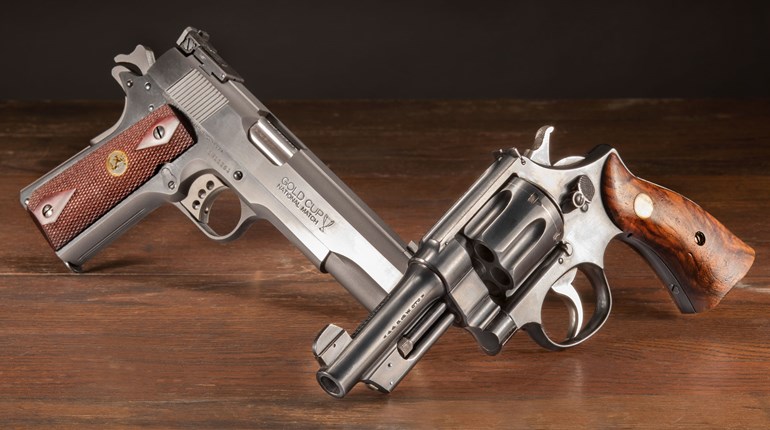
Recently, a group of us were discussing the fact that small handguns are easy to conceal, but difficult to shoot accurately, while big handguns are easier to shoot accurately, but more difficult to conceal. One of the fellows made the comment that, since the average gunfight took place at 7 yards, he would continue to carry his small defensive handgun. The thing I wanted to know is, exactly how do you go about scheduling an average gunfight? And, while we’re at it, how do I go about possibly scheduling my “average” gunfight with a crook who is a really poor shot?
We certainly realize that close-range attacks can be the most deadly. But, there is really no guarantee that a person will have to fight at 7 yards or closer. Murphy’s Law may dictate that you will have to defend against a deadly attack at a distance that is way over on the long side of average.
On July 21, 1865, James Butler “Wild Bill” Hickok was shot at by Davis Tutt in Springfield, MO. Tutt saw Hickok walking onto the square and fired a shot at him, which missed. Hickok braced his gun hand across his left forearm and fired one shot, which hit Tutt’s left side, striking his heart and ending the encounter. Distance? 75 yards.
The first law enforcement agency I worked for required us to qualify at various ranges out to 50 yards. Of course, most of our actual encounters occurred at ranges that were somewhat less than that, but there were a few that proved to be the exception to the rule. Certainly, folks who live and work in rural areas may find that deadly encounters occur well beyond the average. And we might expect any violent attack that occurs out-of-doors to involve distances well beyond 7 yards.
In the past, I have made the statement that distance is your friend. At close range, everyone is a good shot. If the armed citizen creates distance in an encounter, it is in order to prevail over the poorly prepared criminal.
However, this only works if the armed citizen has developed shooting skills to deal with the increased distance. While we might spend the majority of our time practicing to deal with those up-close-and-personal attacks, some practice should always be devoted to firing the defensive handgun at greater distances.
Regardless of what kind of defensive handgun a person chooses to carry, they should know where it hits at greater distances—say 25 to 50 yards. In fact, one might be surprised what a good defensive handgun will do at 100 yards, given some serious practice. If a particular pistol is not capable of good work at increased distances, this might indicate that a change of armament is needed.
While distance may be your friend (with suitable practice), Murphy is not. Don’t expect that you will have to fight for your life at the average range; arm yourself and practice so that you can deal with the threat at whatever ranges an attack might occur.
And, while we are talking about averages, let’s look at the average number of rounds fired in a deadly encounter. Depending upon which source one chooses to study, the average number of rounds fired in a deadly encounter is between two and four. So the guy who likes to bet his life on averages would say that he is good to go with a five-shot, snub-nose revolver with no extra reload.
But, what about the police officer who had to shoot the knife-wielding crook eight times with his .45 ACP before he stopped? Or, we could just examine some of the police shootings that involve 20 (or more) rounds being fired. Misses don’t mean much in a gunfight, no matter how close they are. And, we can’t be assured that the crook, high on dope or wearing body armor, will be impressed when we center punch him two to four times.
We carry extra ammunition to deal with all of those things that can go wrong when the shooting starts. A person’s pistol magazine may decide to give up the ghost right in the middle of a fight and, when it does, it sure would be nice to reach for that extra mag in order to stay in the fight. A defensive shooter may also have to dump his magazine in order to clear a double feed, in which case it is comforting to be able to pull an additional magazine and recharge.
Now, I am not a fan of carrying 20 or 30 rounds of extra ammunition around all day. Besides making concealment more difficult, the stuff just adds a lot of weight to my belt. However—average rounds fired be damned—an extra reload is a really good idea.
The optimist may plan and equip himself with the average gunfight in mind. I have always thought it was a far better idea to plan and equip (within reason) for the worst-case scenario. Knowing how my gun shoots at extended distances and having some extra ammunition is just a guard against an attack from Murphy and his silly law. As the old expression goes, no one involved in a gunfight ever wished they had less ammunition on hand.
The smart defensive shooter will pay little attention to averages as they relate to gunfighting. A gunfight is going to be what it is going to be. Some things we may have control over—like knowing your pistol’s point-of-aim at various distances—but there are other things in that gunfight situation we can’t control. The things we have control over are the items that we need to be giving serious thought to carrying and practicing to deal with as many potential situations as possible. Those “average” components that we cannot change or have any control over will happen, regardless of our designs or desires.


































